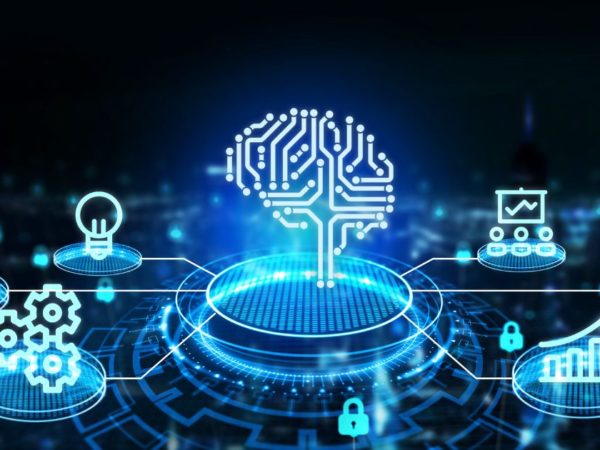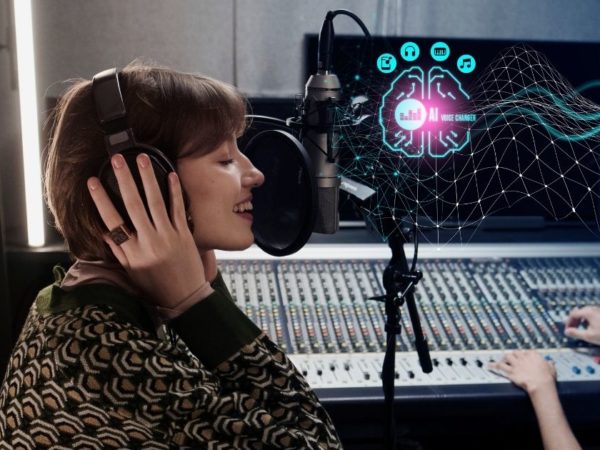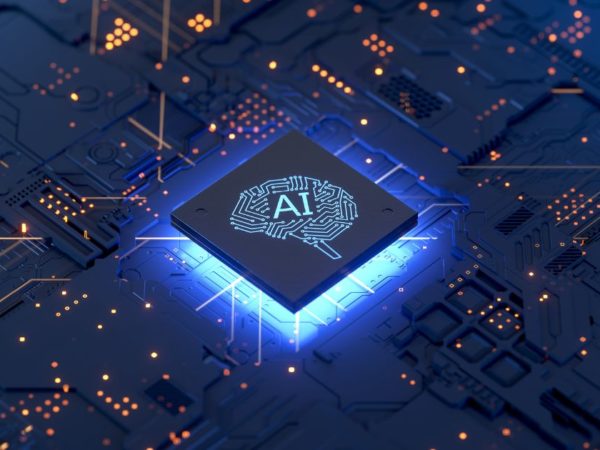Artificial general intelligence makes way for machines that can behave, perform, and learn as we do!
Artificial intelligence has changed the way machine performs work. Today, your computer can do many personal and professional tasks if you train it with AI tools. Some examples are creating images, producing voice from text, controlling utilities, etc.
But these are not truly intelligent. There are lots of months of training behind such automation.
How about a truly intelligent computer application that can learn on its own? That is artificial general intelligence’s domain. Read on to learn this breakthrough technology today!
Introduction
<img alt="YouTube video" data-pin-nopin="true" data-src="https://kirelos.com/wp-content/uploads/2022/12/echo/hqdefault.jpg638db10b9b0b0.jpg" height="360" loading="lazy" src="data:image/svg xml,” width=”480″>
AGI is a technology that can make software and hardware so smart that they express human-like cognitive abilities. It has other names like strong AI, full AI, etc.
To simplify it, you present the smart AGI system with a problem it did not know before. The smart computer will analyze the issue, do some online research, and deliver a solution to the problem.
IBM, OpenAI, Microsoft, Google Brain, Darktrace, Deepmind, etc., are the fast movers in AGI technology. These companies are trying to infuse the following in an engineered smart computer:
- Human-like general intelligence
- Express intelligence is not linked to any specific task like typing or speaking
- Generalize new learnings and link the knowledge with previous experiences
- Make sense from learnings that are qualitatively different
- Perceive and analyze tasks from the real-world context
Currently, there is no true artificial general intelligence (AGI). IBM Strong AI and Google Brain are making some progress, but these are not production-ready.
Benefits and Needs
We need AGI to replace human beings in hazardous places. Also, AGI computers can deliver an unforeseen level of productivity in business operations.
AGI applications will also help the human race to solve tough puzzles in medicine, healthcare, supply chain, economics, finance, and social sciences.
Here are some other vital reasons for developing an AGI:
- AGI applications can exhibit a better understanding of cause and effect to help humans with risk assessment projects.
- AGIs can effectively use various sensory perceptions like color, sound, depth, visuals, and dimensions.
- Such intelligent computer programs can command a robotic arm to perform fine motor skills like assembling electronic devices from start to finish.
- The natural language processing (NLP) capability of an AGI will make automation easier. You can just speak some keywords, and the AGI tool shall build the automated flow you need.
- AGIs can solve unique problems after looking at the issue and analyzing the real-world environment. There is no need to meet any If/Then, If/Else, etc., conditions.
- AGIs can help content creators, artists, designers, and architects with out-of-the-box ideas.
- AGI apps can offer excellent customer service without any miss since they will also exhibit emotional and social intelligence.
AI vs. AGI
#1. Mode of Action
AI, aka narrow AI, is a reactive smart application. It will react with a preset list of actions when it receives signals from event triggers.
AGIs will not need any event triggers. These apps will respond proactively, like humans, to prevent problems, solve puzzles, etc.
#2. Scope of Action
Narrow or weak AIs also have a limited scope of work. A writing AI shall not drive a car and vice versa. The limited application also makes development costly and inefficient at the production level.
One AGI could run a whole manufacturing plant, thousands of homes in a locality in a region, or all the company offices of your business. It is open to any challenge since it has cognitive learning, reasoning, and proactive action-taking capabilities.
#3. Problem-Solving Skills
Narrow AIs mostly solve close-ended problems like GPS navigation, web search based on keywords, AI writing, AI code completion, etc.
Artificial general intelligence can handle open-ended problems like creating a field marketing strategy by analyzing the market, customers, and products.
#4. Memory Capacity
Most weak AI programs are based on limited memory machines. AIs rely on a set of artificial neural networks and training databases. When the database or algorithms are old, AIs get stuck.
AGIs will come with virtually infinite memory (knowledge resources) via local databases, cloud databases, and the Internet.
#5. Upgrades
Humans need to upgrade weak AIs regularly as business requirements and market trends change.
AGIs will upgrade their memories and databases themselves. It shall not ask for human intervention.
Approaches
#1. The sub-symbolic approach
Here, AGI developers use applications that resemble the human brain. For example, DeepMind’s AlphaGo, convolutional neural networks, deep learning systems, etc.
#2. The symbolic approach
In this method, AGI developers use flow charts, symbols, and if-then statements. Artificial general intelligence uses a primary algorithm to learn and create a knowledge base. Further, it can compare the algorithm and its symbols with real-world aspects and develop better thought processes than weak AIs.
#3. Whole Body Approach
<img alt="YouTube video" data-pin-nopin="true" data-src="https://kirelos.com/wp-content/uploads/2022/12/echo/hqdefault.jpg638db10c2e4f4.jpg" height="360" loading="lazy" src="data:image/svg xml,” width=”480″>
In this concept, AGI developers want to include all the software, hardware, network, and sensory capabilities in a human-like body. The humanoid can walk, talk, touch people, and so on.
#4. The Hybrid Approach
The hybrid way to AGI development relies on the sub-symbolic and symbolic approaches.
A successful example of this category is Sophia, a humanoid robot. It comprises both symbolic and connectionist systems. For example, Sophia needs the CogPrime architecture and AtomSpace database for its functionalities.
#5. Mathematical Approach
Researchers aim to allocate the AGIs infinite computational power. Hence, these smart apps and devices will be able to perform the required number of mathematical problem-solving to make outstanding decisions.
How Does AGI Work?
An AGI program will utilize various technologies to achieve human-level cognitive abilities. These are as below:
Input and Output (I/O)
AGIs use various sensory devices to perform their tasks in manufacturing plants or as self-driving cars. These sensors could be visual, RFID, temperature, pressure, speed, motion, etc.
Another group of AGIs may require OCR, database connectors, etc., to perform business operations in offices.
Motor Skills
Whole-body, robotic arms, autonomous vehicles, etc., work by making fine movements. AGIs rely on motor skills acquired from neural networks, 3D image processing, visual mimicking, etc.
NLP
An AGI can learn from various sources like website articles, research journals, eBooks, YouTube videos, etc. For this purpose, the smart application first learns to interpret natural language into machine language.
Reasoning and Problem-Solving
An AGI robot or application often uses simulations to solve a unique problem. Since it has huge processing and memory capabilities, the machine can run multiple simulations simultaneously. Then, according to the success rate, it can choose one simulation.
Creative Thinking
AGIs can use multiple neural networks to create unique and creative ideas like art forms, music notes, articles, etc.
Facial Recognition and Sound Processing
Humanoid AGIs that interact with people mostly use sound analysis and facial recognition. After processing the audio and visuals from its environment and cross-checking with existing knowledge bases, it can interact with humans.
Challenges
Artificial general intelligence has an immense possibility to transform the world of AI. But reaching this stage is not a smooth process. Here are the challenges and hindrances of developing an AGI:
#1. Mastering Human-Like Skills
To obtain true human-level intelligence, an AGI has to master some abilities. These include motor skills, natural language understanding, sensory perception, emotional and social connection, and human-level creativity.
#2. Absence of Working Protocol
There are no standard working protocols of AI systems for effortless collaboration. Hence, deploying a comprehensive AGI system faces unavoidable technical deficiencies.
#3. Lack of Business Alignment
The integration of AI into existing systems remains a complex process. As the concerned stakeholders are still unaware of its operational parameters, keeping its development aligned with the business goals is difficult.
#4. Communication Gaps
There is still a communication gap between separate AI systems. Since seamless data sharing between these systems is impossible, the inter-learning of the AI models is hampered, and its universality gets reduced.
#5. Absence of AGI Direction
There are no plans or directions for implementing AGI in enterprise business operations. Thus, its implementation becomes costly, and realization gets hindered.
Trends
As you know, complete artificial general intelligence development is yet to be achieved. However, these AI trends will influence AGI:
#1. Natural Language Processing (NLP)
NLP or Natural language Processing refers to the process by which AI can understand human language and convert it into machine-supported codes. Utilizing NLP, AGI can expect to be able to interact with humans realistically.
#2. Metaverse
Metaverse is a technology that offers an immersive user experience. With more people interested, AGI will evolve to assist Metaverse in building a virtual world.
#3. Low-Code or No-Code AI
There is an increasing demand for low-code or no-code solutions, even for AI tools and algorithms. These solutions come with intuitive interfaces for making complex app development processes easier.
#4. Workforce Augmentation
It means humans and digital employees working in an organization side by side. Though many fear AI will make humans unemployed, including AI in operations will make it more efficient.
#5. Quantum AI
Quantum AI has a high chance of influencing AGI by speeding up ML algorithms and helping you get results at a quick speed. It can also neutralize the obstacles AGI might face analyzing a huge volume of data.
#6. AI Ethics
The potential risks of AI are impossible to ignore. If not utilized properly, AI could be hazardous for humankind. Hence, AI ethics will get more attention in the coming years.
#7. AI Chatbots
AI chatbots or virtual assistants can have a natural conversation and perform rule-based operations. Replacing human support agents, these chatbots have already reduced operational costs for enterprises. In the future, this can revolutionize AGI.
Risks of AGI
<img alt="YouTube video" data-pin-nopin="true" data-src="https://kirelos.com/wp-content/uploads/2022/12/echo/hqdefault.jpg638db10ce2032.jpg" height="360" loading="lazy" src="data:image/svg xml,” width=”480″>
- If the database of the AGI is limited, it can make disastrous decisions damaging businesses and homes.
- AGIs can become targets of advanced hacking attacks. If a hacker stalls an AGI machine, it could damage the whole business.
- AI developers have reported various incidents of biased decisions taken by prototype AGIs.
- Giving AGIs unrestricted database access could also violate various privacy regulations across the globe.
Next, we will check out real-world examples of Artificial General Intelligence.
Real-World Examples
#1. ROSS’s AI Search
The AI attorney ROSS can search billion of legal documents in under three seconds. You can input any legal question, and it will deliver pinpoint answers.
It is an AGI because it utilizes various smart technologies like ranking, retrieval, and understanding. Also, it has a broader scope of action since it covers all the niches of the legal domain.
#2. AlphaGo
AlphaGo is an AI-based Go board game player. It is the first smart machine that defeated a professional living Go player. Though this is an AI with a limited scope of action, it has self-learning capabilities. AlphaGo can learn from its competitor and its own mistakes.
#3.OpenAI’ss Bundled AI Tools
OpenAI’s range of AI systems, as mentioned below, can accomplish various tasks automatically when combined using API calls:
- GPT-3 creates natural language-based texts from simple phrases and clues. Many online games and mixed reality experiences like FableStudio’s story-driven “Virtual Being” use GPT-3 for interactive stories.
- Codex helps developers to translate natural language inputs into codes for convenient coding.
- DALL·E assists NFT creators and digital artists in producing thousands of original and unique artwork in a few minutes. The AI can also edit images.
#4. IBM Watson
<img alt="YouTube video" data-pin-nopin="true" data-src="https://kirelos.com/wp-content/uploads/2022/12/echo/hqdefault.jpg638db10cf2e71.jpg" height="360" loading="lazy" src="data:image/svg xml,” width=”480″>
IBM Watson is a full-service AI bundle for businesses. We can call it an AGI since it has various applications. There are different Watson AIs, and these are as below:
- IBM Watson Assistant for customer service or virtual assistance
- IBM Watson Discovery creates insights and answers from complex business documents
- IBM Watson Natural Language Understanding and Classifier
Final Words
So far, you have explored the artificial general intelligence concept. You have also learned its working, challenges, examples, risks, and more.
Learning the above will help you plan your artificial intelligence development projects correctly. It must be flexible enough to include next-generation smart applications in your project and make it an AGI.
If you are a business looking to make operations more productive and cost-effective, AGI could be the answer though more developments are underway.
Next, you can check out more about machine learning.



